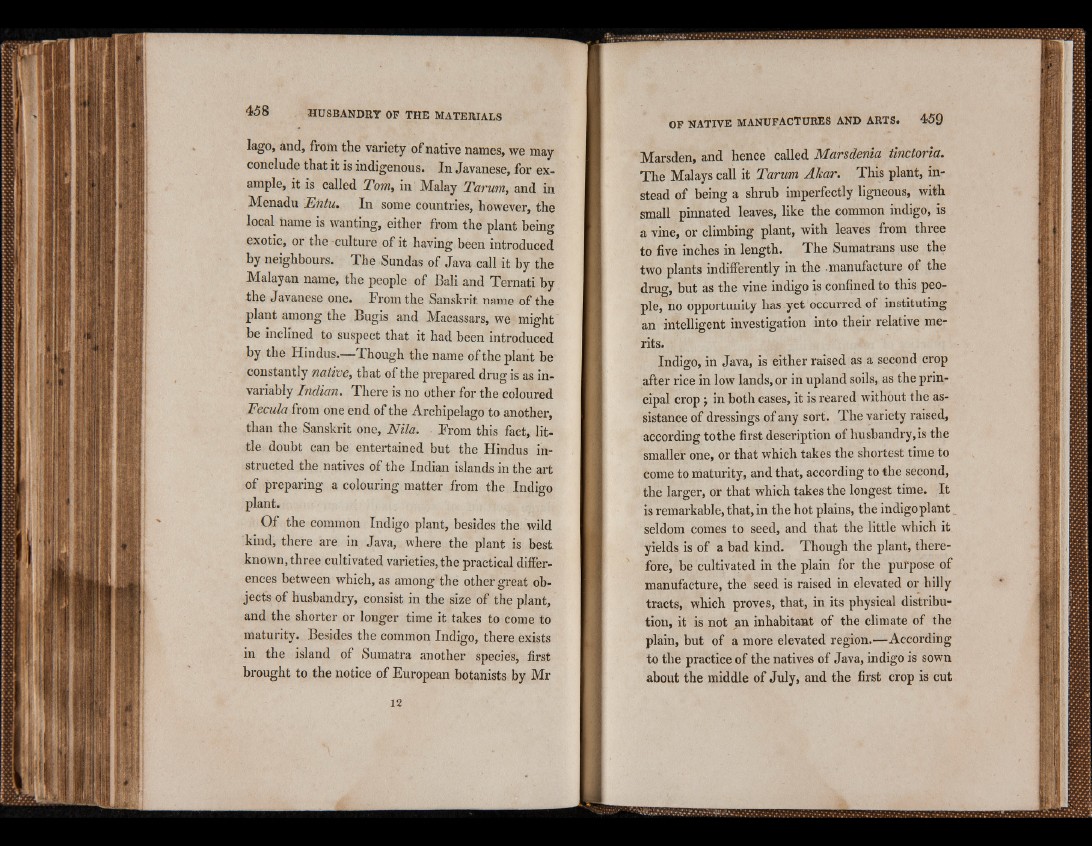
lago, and, froin the variety of native names, we may
conclude that it is indigenous. In Javanese, for example,
it is called Tom, in Malay Tarum, and in
Menadu Entu. In some countries, however, the
local name is wanting, either from the plant being
exotic, or the culture of it having been introduced
by neighbours. The Sundas of Java call it by the
Malayan name, the people of Bali and Ternati by
the Javanese one. From the Sanskrit name of the
plant among the Bugis and Macassars, we might-. * • * 7 o
be inclined to suspect that it had been introduced
by the Hindus.—Though the name of the plant be
constantly native, that of the prepared drug is as invariably
Indian. There is no other for the coloured
Fecula from one end of the Archipelago to another,
than the Sanskrit one, Nila. • From this fact, little
doubt can be entertained but the Hindus instructed
the natives of the Indian islands in the art
of preparing a colouring matter from the Indigo
plant.
Of the common Indigo plant, besides the wild
kind, there are in Java, where the plant is best
known, three cultivated varieties, the practical differences
between which, as among the other great objects
of husbandry, consist in the size of the plant,
and the shorter or longer time it takes to come to
maturity. Besides the common Indigo, there exists
in the island of Sumatra another species, first
brought to the notice of European botanists by Mr
12
Marsden, and hence called Marsdenia tinctoria.
The Malays call it Tarum Ahar. This plant, instead
of being a shrub imperfectly ligneous, with
small pinnated leaves, like the common indigo, is
a vine, or climbing plant, with leaves from three
to five inches in length. The Sumatrans use the
two plants indifferently in the .manufacture of the
drug, but as the vine indigo is confined to this people,
no opportunity has yet occurred of instituting
an intelligent investigation into their relative merits.
Indigo, in Java, is either O 7 • raised as a second crop
after rice in low lands, or in upland soils, as the principal
crop j in both cases, it is reared without the assistance
of dressings of any sort. The variety raised,
according to the first description of husbandry, is the
smaller one, or that which takes the shortest time to
come to maturity, and that, according to the second,
the larger, or that which takes the longest time. It
is remarkable, that, in the hot plains, the indigo plant
seldom comes to seed, and that the little which it
yields is of a bad kind. Though the plant, therefore,
be cultivated in the plain for the purpose of
manufacture, the seed is raised in elevated or hilly
tracts, which proves, that, in its physical distribution,
it is not a,n inhabitant of the climate of the
plain, but of a more elevated region.—According
to the practice of the natives of Java, indigo is sown
about the middle of July, and the first crop is cut